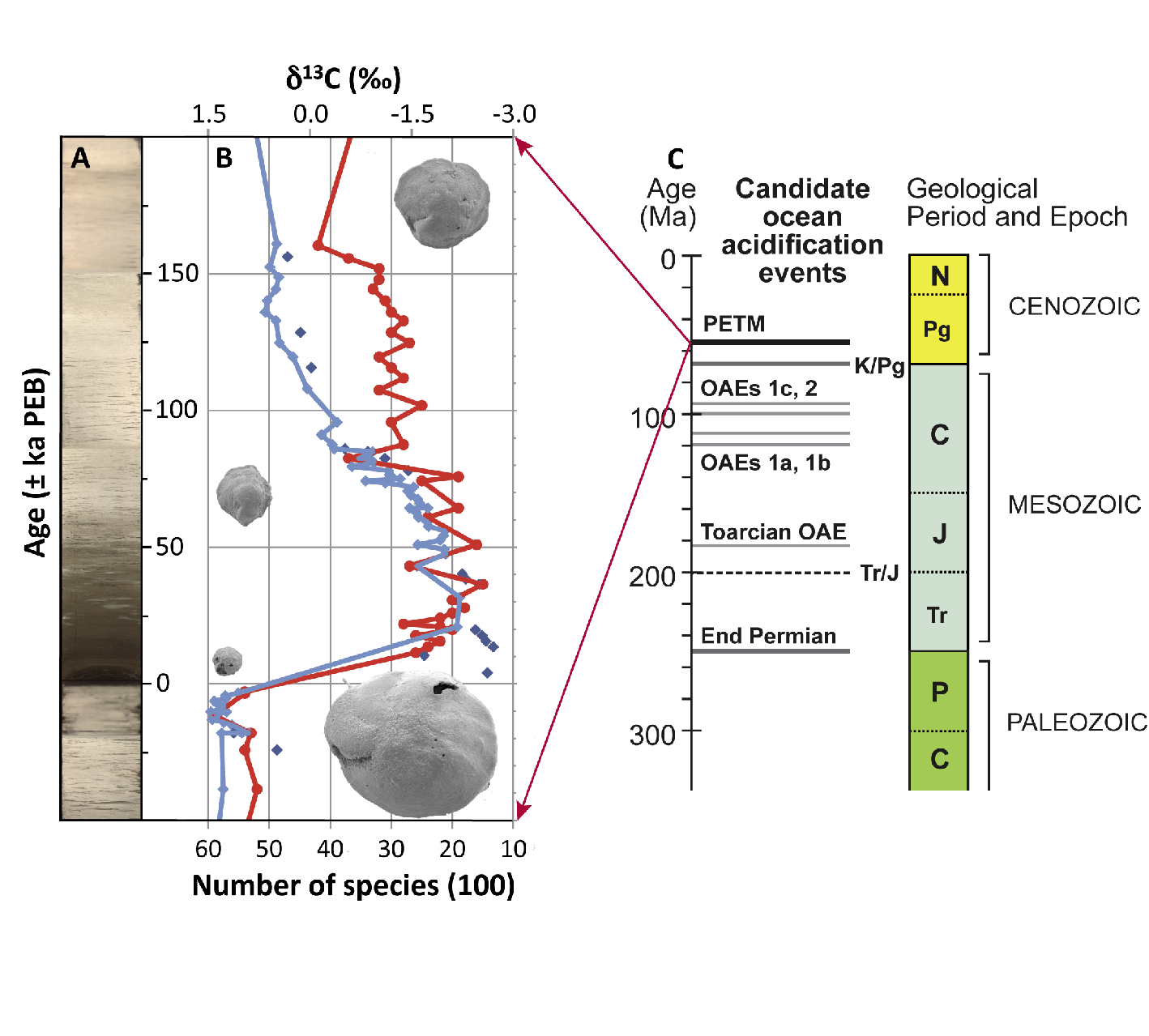- Home
- Publications
- PAGES Magazine
- Ocean Acidification - How Will Ongoing Ocean Acidification Affect Marine Life? [Past]
Ocean Acidification - How will ongoing ocean acidification affect marine life? [Past]
Ellen Thomas
PAGES news
20(1)
37
2012
Ellen Thomas1,2
1Department of Geology and Geophysics, Yale University, New Haven, USA; ellen.thomas yale.edu
yale.edu
2Department of Earth & Environmental Sciences, Wesleyan University, Middletown, USA
Scientists use the geological record to ”look back into the future”, i.e. to evaluate effects of ocean acidification on whole marine ecosystems during carbon cycle-climate perturbations (Pelejero et al. 2010). Fortuitously, calcifying organisms, affected most immediately by decreased carbonate saturation (Fig. 1), have left a fossil record: planktic foraminifera and calcareous nannoplankton (coccolithophores) provide information on the effects of ocean acidification on calcifiers in surface oceans, benthic foraminifera and ostracodes in the deep sea, and corals, calcareous algae, echinoderms, bivalves and gastropods in shelf environments (Kiessling and Simpson 2011).
Where in the past can we find clues about future ocean acidification? To look at a world with CO2 levels higher than today (>389 ppm) we need to go back into “Deep Time” (Kump et al. 2009; NRC 2011). During transitions from glacial to interglacial periods over the last 2.6 million years (Ma), atmospheric CO2 levels increased by ~90 ppm over a few thousand years, but from ~175 to ~185 ppm, i.e. well below present levels. Atmospheric CO2 levels may not have been above ~400 ppm for the last 35 Ma, the time since when ice sheets existed on Antarctica. The Deep Time warm worlds are not perfect analogs for the near future, among other reasons because life has evolved since then, but nevertheless may provide useful insights.
The long-term high pCO2 and low pH levels in Deep Time did not result in low carbonate saturation states (Ω) in sea water, because on time scales of 10-100 ka the burial of CaCO3 in marine sediments balances the cations released by rock weathering on land, and deep-sea carbonate dissolution buffers the oceans’ Ω. This buffering has been possible only since ~180 Ma, when open-ocean calcifiers evolved and their remains started accumulating as deep-sea carbonates. Since then, only particularly rapid addition of CO2 (over centuries, as during fossil fuel burning) results in a coupled decline of pH and saturation state. Studying past ocean acidification thus requires recognition of times when atmospheric CO2 levels increased rapidly, e.g. from dissociation of methane hydrates from seafloor sediments, methane buildup and release from intrusion of magma into organic-rich sediments, volcanic outgassing, or rapid oceanic turnover of CO2-rich deep waters.
Such climate - carbon cycle perturbations are recognized in the geological record by the co-occurrence of a negative carbon isotope excursion (CIE), which reflects the release of large amounts of isotopically light carbon into the ocean-atmosphere system, combined with proxy evidence for global warming and sea floor carbonate dissolution (Kump et al. 2009). During the 543 Ma of Earth history when animals existed (the Phanerozoic), perturbations occurred at the Permo-Triassic (P/Tr) boundary (~250 Ma), the Triassic-Jurassic (Tr/J) boundary (~200 Ma), during Oceanic Anoxic Events (OAEs) between ~183 and 93 Ma (Jurassic-Cretaceous), during the Paleocene-Eocene Thermal Maximum (PETM) (~55 Ma) and during smaller “hyperthermals” in the Paleogene (~65-40 Ma) (McInerney and Wing 2011). All these events resemble our possible future, with a CIE, global warming, ocean acidification and deoxygenation, thus various stressors affecting the biota. Severe extinctions (including reef biota) occurred at the P/Tr and Tr/J boundaries, i.e. before the evolution of ocean buffering. These early geological events are well suited to provide insight in processes following C-release at rates too rapid for buffering. Later acidification episodes were not associated with severe net extinction of oceanic calcifiers, although coralgal reefs and deep-sea benthic foraminifera suffered extinction during some OAEs and the PETM. Rates of speciation and extinction of calcareous nannoplankton and planktic foraminifera accelerated at or near the OAEs and across the PETM, and “deformed” nannoplankton has been reported, although these could be due to dissolution during or after deposition on the seafloor. The transient floral and faunal changes typically took at least several 10 ka to recover.
The best approximations of CO2 emission rates during past carbon cycle perturbations indicate that emissions were considerably slower than the ongoing anthropogenic CO2 emission. The geological record suggests that the human “grand geophysical experiment” is unprecedented, with the high rates of emission potentially having severe and long-term effects on oceanic biota.
selected references
Full reference list online under: http://pastglobalchanges.org/products/newsletters/ref2012_1.pdf
Hönisch B et al. (in press) Science
Kiessling W and Simpson C (2011) Global Change Biology 7: 56-67
Kump LR, Bralower TJ and Ridgwell A (2009) Oceanography 22(4): 94-107
McCarren H et al. (2008) Geochemistry, Geophysics, Geosystems 9, doi: 10.1029/2008GC002116
McInerney FA and Wing SL (2011) Annual Reviews of Earth and Planetary Sciences 39: 489-516
